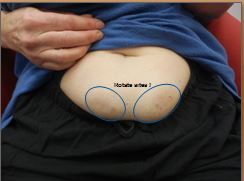Jayne Lehmann RN CDE
The Forum for Injection Technique UK (FIT) published the 3rd edition of its Injection Technique Recommendations in 2015. Since then, the guidelines have underpinned clinical and education practice in this area of diabetes care and education.
The assessment of the abdomen or other injection site/s helps to pick-up any lumps and bumps from repeated insulin injections into the same areas. It’s called lipohypertrophy, and is a common cause of unstable diabetes. Insulin is a growth hormone and it creates an over production of scarred tissue where the insulin sits under the skin. Insulin absorption then differs, depending on whether or not it is injected into the area of lipohypertrophy.
People inject into the same places because they either haven’t been taught how to significantly rotate their injection sites, have forgotten or like the fact it doesn’t hurt when injecting into the scarred tissue.
The insulin dose then needs to rise in order to be effective in the scarred tissue. Dosing into non-scarred areas, can cause significant hypoglycaemia ( hypo) as the dose works too effectively when away from the scar tissue.
I’ve increased the rate of injection site review I do in people with diabetes who inject their medication and have been surprised at how many people have these lumps and bumps. Many will be found either side of the belly button, indicating a pattern of injecting that moves from one side to the other, limiting the rotation of sites.
Why are the lumps and bumps of lipohypertrophy so commonly identified? Did we diabetes health professionals take our eye off the ball in this area of preventive care?
Probably. I wonder if we thought the newer insulin’s wouldn’t cause these issues and even remember hearing this would be the case when the human insulins were launched. Don’t get me wrong, we’ve been encouraging people to rotate their injection sites but have we been doing routine assessment of injection sites since the new insulin’s were introduced?
Then there are the images depicting insulin delivery sites in company brochures and diabetes education material – they haven’t helped either. They often show the abdomen injection site as a narrow area just above and below the belly button – and it often looks like the image is injecting just to the side of the belly button as well. No wonder people continue to go side to side, especially when it is also where the hand goes most naturally to do the injection. The illustrations need to be updated to clearly show the whole abdomen from under the breasts and right out to the sides with crosses all over the abdomen to indicate the extent of the rotation of sites.
Nurses also reinforce the incorrect technique by frequently injecting side to side and not keeping track of where injections are given by many different nurses. A well designed form and updated procedures, undergraduate curriculums and professional development will help here.
Nurses in primary care can encourage people having their Gp Management Plan/Team Care Arrangement prepared to include at least one appointment with a Credentialled Diabetes Educator/year. This provides opportunities to discuss issues like the rotation of sites and a check of the length of their needles, which are recommended to be 6mm or less to help prevent inadvertent intra-muscularly injections; another of the FIT UK Guidelines.
Click here to download a copy of the guidelines and use it to review your practice in this area of diabetes care.


